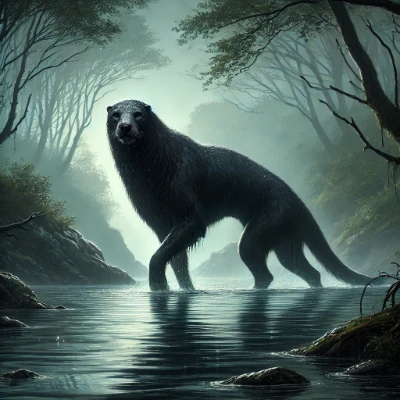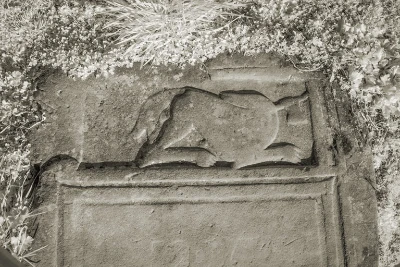Irish Folklore Beasts: Dobhar-chú

Legend whispers of a fierce creature lurking in Ireland’s lakes: part otter, part hound, with a reputation as savage as it is elusive. Known as the Dobhar-chú—Irish for “water hound”—this cryptid has captured the imaginations of locals and visitors alike for centuries. In this blog post, we’ll dive into the history and mythology surrounding the Dobhar-chú, explore its role in Irish culture, and consider modern interpretations of the legend.
What Is the Dobhar-chú?
The name “Dobhar-chú” comes from two Irish words: dobhar (meaning “water”) and cú (meaning “hound” or “dog”). However, this creature is often described as more otter-like than canine—albeit a very large and aggressive otter. Some stories depict it as part dog and part fish, highlighting its semi-aquatic nature and the awe (and fear) it inspires in those who claim to have encountered it. The Dobhar-chú is said to be incredibly strong and agile, both in and out of the water.
Folklore and Legends
Ancient Roots
Tales of mysterious water beasts and guardian spirits are woven throughout Celtic and Irish mythology. As an island nation, Ireland’s folklore frequently features lakes and waterways as gateways to the unknown or realms of hidden danger.
Famous Tale (Glenade Lake)

Perhaps the most famous Dobhar-chú story comes from Glenade Lake in County Leitrim. According to legend, a local woman was attacked and killed by a Dobhar-chú while washing clothes at the lakeshore. Her husband pursued and ultimately slew the beast, only to be chased by its mate—a dramatic tale that underscores the Dobhar-chú’s ferocity. In Conwall Cemetery near Glenade Lake, a gravestone from the 18th century bears an engraving some believe to depict the Dobhar-chú, adding to the legend’s intrigue.
Other Local Stories
Variations of the Dobhar-chú myth pop up in folklore from surrounding regions. Some accounts focus on its supernatural qualities, while others describe it as a naturally evolved but rare predator. These stories have been passed down for generations, preserving the creature’s place in Irish cultural memory.
Symbolism and Cultural Context
The Dobhar-chú represents nature’s power and mystery, especially the untamed waters of Ireland’s lakes. In many older European legends, water is often painted as a realm of hidden perils—fittingly guarded by fierce creatures like the Dobhar-chú. Comparisons can be made to Scotland’s Loch Ness Monster or the mythical kelpie; both echo themes of caution and respect for the dangers that lurk beneath the surface. Folklore acts as a cultural time capsule, reminding us of a past when storytelling was vital for explaining life’s unknowns and keeping people safe.
Sightings and Modern Interpretations
Despite centuries of tales, modern-day sightings of the Dobhar-chú are few and far between—though urban legends and anecdotal reports still surface. Some cryptid enthusiasts believe the Dobhar-chú could be a misidentified giant otter or a seal glimpsed in low light. Others argue that the legend is pure myth, born from local lore and embellished through storytelling. Regardless, the possibility of encountering a “water hound” fascinates many cryptozoologists and casual fans of the unexplained.
The Dobhar-chú in Popular Culture
Interest in the Dobhar-chú persists thanks to local tourism, artwork, and online discussion. Tourists visiting counties like Leitrim often hear the tale at local pubs or see references in souvenir shops. Folk musicians have even written songs about the beast, and you can find its likeness in everything from T-shirts to tattoos, lending the Dobhar-chú a small but loyal fan base. Debates about the creature’s authenticity and potential origins on social media and in cryptid forums keep the legend alive in the digital age.
Conclusion
The Dobhar-chú stands at the crossroads of folklore and cryptid lore, embodying Ireland’s deep-seated respect for natural forces that can be life-giving and deadly. Whether seen as a cautionary tale, a guardian spirit, or a legitimate cryptid that occasionally surfaces in our modern world, its story underscores the power of myth in shaping cultural identity. In the end, the Dobhar-chú serves as a reminder that some mysteries—especially those born of water—may forever remain part legend, part reality.
Additional Resources
- Suggested Reading:
- The Field Guide to Lake Monsters, Sea Serpents, and Other Mystery Denizens of the Deep by Loren Coleman
- Irish folklore collections by the National Folklore Collection, University College Dublin
- Local Sites & Attractions:
- Glenade Lake, County Leitrim: Explore the scenic waters associated with the Dobhar-chú’s most famous tale.
- Conwall Cemetery: Home to the 18th-century gravestone reputedly depicting the Dobhar-chú.
- Online Communities:
- Cryptid-focused subreddits on Reddit
- Facebook groups dedicated to Irish folklore and mythology
Dive deeper into Ireland’s tales and legends, and you’ll find that creatures like the Dobhar-chú still hold the power to captivate our imaginations, proving the enduring magic of a well-told story.
